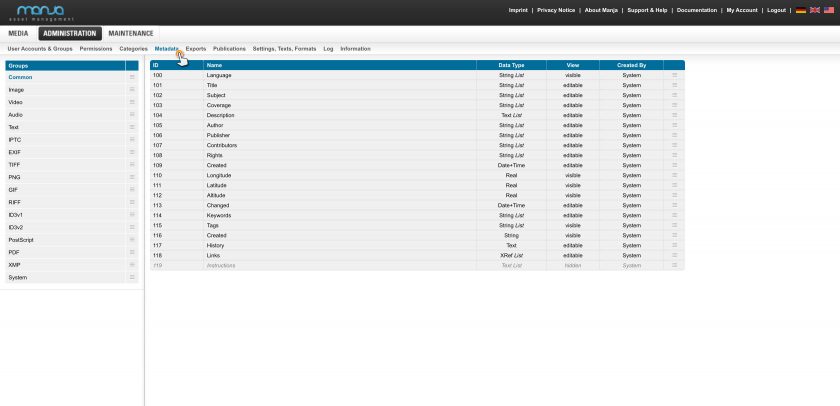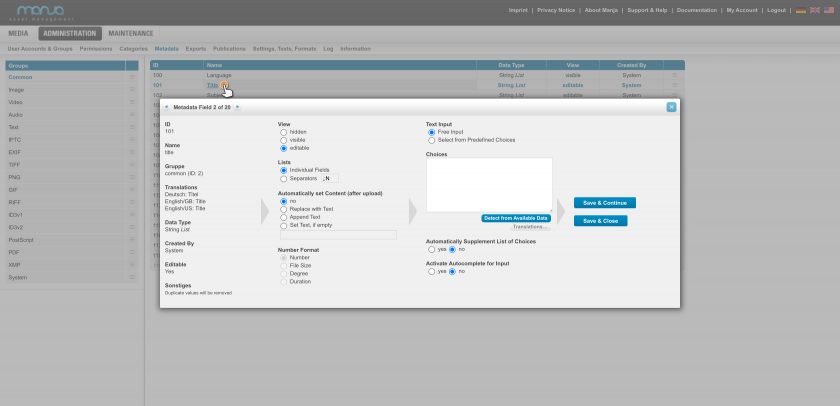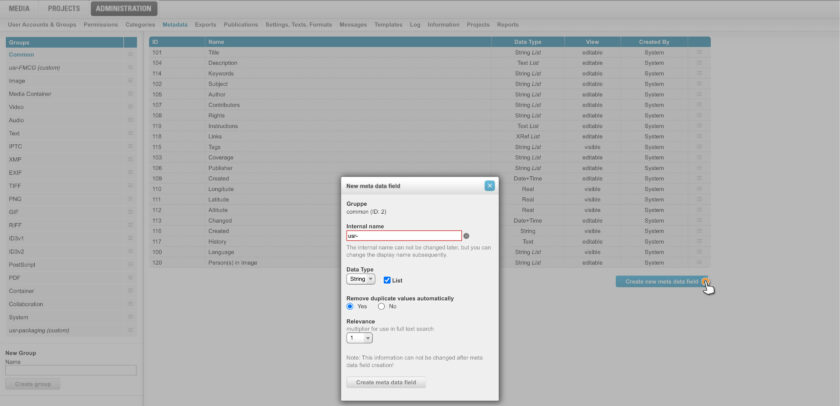Administration
Create and edit new metadata fields
Metadata is technical information that is stored and supplied within a file. When files are uploaded to Manja, this metadata is read and applied. The metadata embedded in the managed files is viewable and searchable in Manja.
Which metadata fields and which configuration options are available in Manja? This question is answered in the chapter of this documentation.
General information about the metadata of a file and how to use it is described in the chapter Detail View.
Tip: On our page Features & Add-ons we have compiled an informative overview of all our features. Additionally, we offer more information about metadata on our page Manage and organize files.
Viewing and editing metadata fields
Back to topOn the left side, you can see the list of metadata groups. By using the drag point right to each category you can resort the groups – according to your requirements.
On the right side, you can see the list of metadata fields of the selected group. You can resort the fields too.
Clicking on a field opens the dialog for configuration of the field. According to the properties of the metadata field, here you can configure its presentation and input options.
Create new metadata field
Back to topUnder “Metadata” in the administration area, new metadata fields can be created as well as removed.
Furthermore, you can also create and remove your own metadata groups.
Fields/choices when creating a new metadata field
Internal name
The internal name is a technical name introduced by “usr-“. The internal name cannot be changed afterwards. However, in the further course of creating a new metadata field there is the possibility to set the display name of the metadata field (“translations”).
Data types
String (preselected)
With the setting “String” the type and content of the metadata field is set to all characters of the alphabet, numbers and special characters. The content of the metadata field is defined as one line.
Example: Coca Cola 0,75l bottle
Text
With the setting “Text” the type and content of the metadata field is set to letters. The content of the metadata field is defined as multiple lines.
Example: Coca Cola
Integer
With the “Integer” setting, the type and content of the metadata field is set to integers.
Example: 12345
Real
The “Real” setting sets the type and content of the metadata field to whole, real numbers, but also to fractional values.
Example: 0.75 or 12345
Binary
With the “Binary” setting, entries in the metadata field are stored without spaces (binary data).
Example: CocaCola
Date
With the setting “Date” as data type the content is set to a date. This defines day, month and year as format.
Example: 31.12.2022
Time
With the setting “Time” the type and content of the metadata field is set to the time specification of hours, minutes and seconds.
Example: 16:02:59
Date+Time
The “Date+Time” setting is a combination of the “Date” and “Time” settings. This sets day, month and year as well as hours and minutes as combined content.
Example: 12/31/2022, 16:02:59
XRef
This setting causes that links or references can be set within Manja.
Example: ” 1 | ” Files with link set to 1
Object
The setting “Object” sets the type and content of the metadata field to structured data. This data refers to other objects within Manja.
List
The checkbox is preselected.
Please read the definition of “Lists” below in the topic “Metadata display“.
Automatically remove duplicate values
Here the value “Yes” is preselected. This can be set to “No”.
This setting prevents duplications from occurring when entering values. When assigning default values, duplication of the same information should be avoided – this is what this setting is for. It is recommended to leave the setting at “Yes”.
Relevance
Relevance serves as a multiplier for the full text search. It can be used to determine how high the data in the metadata field is prioritized and accordingly given a higher relevance value in the full-text search. The range of the relevance multiplier is 1-10. The default value is “1”.
Metadata display
Back to topView
Select between visible, editable and hidden.
Editable means: Users with the necessary permission to edit files can change the content of this field for actual files. An appropriate input field will be generated, according to type and (the following) configuration.
Lists
Select between “Individual Fields” and “Separators”. If you select “Separators”, then enter the appropriate seperators here. The first character in the list (e.g. a comma) will be used for presentation. A big “N” stands for a line break.
This setting influences both presentation and input of data. For fields, which rarely contain more than one value (e.g. author or publisher), the setting “Individual Fields” is prefered.
For fields, that usually contain multiple values (e.g. keywords, tags, links) the setting “Separators” is prefered.
Number Format
- Number – unmodified presentation and input as a number
- File Size – presentation as byte size, with suffix “B”, “kB”, “MB” or “GB” according to actual value
- Degree – presentation with suffix “°”
- Duration – presentation as duration “MM:SS.ms”
Text Input
Select between “Free Input” and “Select from Default Values”.
With “Free Input” the user can enter arbitrary data. In the “Select from Default Values” mode the user may just select one of the configured default values.
Default Values
List of Default Values – one value per line. These are the values, that the user may select in text input mode “Select from Default Values”.
In text input mode “Free Input” these values are just suggestions for the user.
Automatically Supplement List of Values
If set to yes, then additional values will be suggested to the user. These come from values that were entered in the same field on other files.
Activate Autocomplete for Input
If set to yes, then suggestions will be presented directly while typing.


